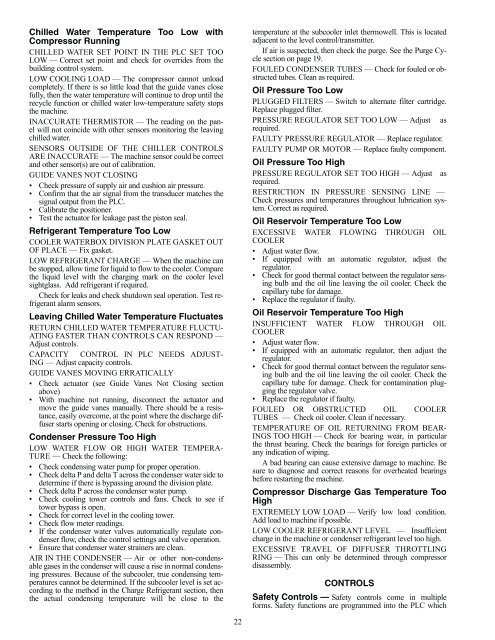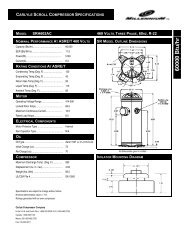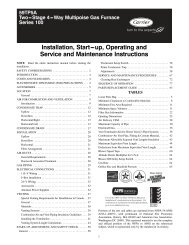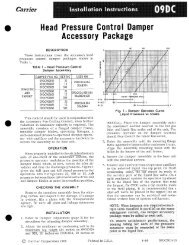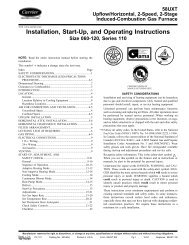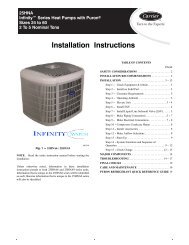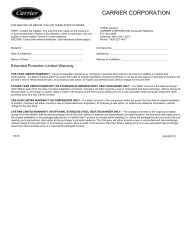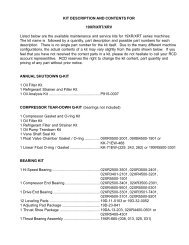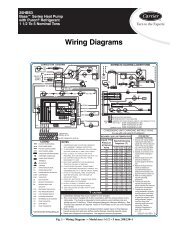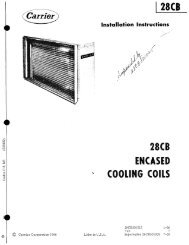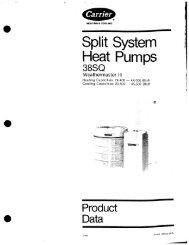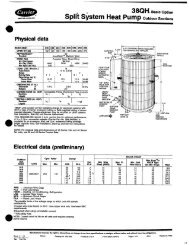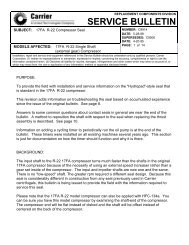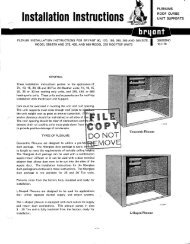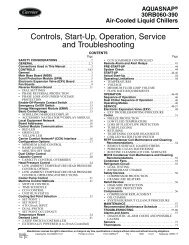Start-Up, Operation, and Maintenance Instructions - Carrier
Start-Up, Operation, and Maintenance Instructions - Carrier
Start-Up, Operation, and Maintenance Instructions - Carrier
Create successful ePaper yourself
Turn your PDF publications into a flip-book with our unique Google optimized e-Paper software.
Chilled Water Temperature Too Low with<br />
Compressor Running<br />
CHILLED WATER SET POINT IN THE PLC SET TOO<br />
LOW — Correct set point <strong>and</strong> check for overrides from the<br />
building control system.<br />
LOW COOLING LOAD — The compressor cannot unload<br />
completely. If there is so little load that the guide vanes close<br />
fully, then the water temperature will continue to drop until the<br />
recycle function or chilled water low-temperature safety stops<br />
the machine.<br />
INACCURATE THERMISTOR — The reading on the panel<br />
will not coincide with other sensors monitoring the leaving<br />
chilled water.<br />
SENSORS OUTSIDE OF THE CHILLER CONTROLS<br />
ARE INACCURATE — The machine sensor could be correct<br />
<strong>and</strong> other sensor(s) are out of calibration.<br />
GUIDE VANES NOT CLOSING<br />
• Check pressure of supply air <strong>and</strong> cushion air pressure.<br />
• Confirm that the air signal from the transducer matches the<br />
signal output from the PLC.<br />
• Calibrate the positioner.<br />
• Test the actuator for leakage past the piston seal.<br />
Refrigerant Temperature Too Low<br />
COOLER WATERBOX DIVISION PLATE GASKET OUT<br />
OF PLACE — Fix gasket.<br />
LOW REFRIGERANT CHARGE — When the machine can<br />
be stopped, allow time for liquid to flow to the cooler. Compare<br />
the liquid level with the charging mark on the cooler level<br />
sightglass. Add refrigerant if required.<br />
Check for leaks <strong>and</strong> check shutdown seal operation. Test refrigerant<br />
alarm sensors.<br />
Leaving Chilled Water Temperature Fluctuates<br />
RETURN CHILLED WATER TEMPERATURE FLUCTU-<br />
ATING FASTER THAN CONTROLS CAN RESPOND —<br />
Adjust controls.<br />
CAPACITY CONTROL IN PLC NEEDS ADJUST-<br />
ING — Adjust capacity controls.<br />
GUIDE VANES MOVING ERRATICALLY<br />
• Check actuator (see Guide Vanes Not Closing section<br />
above)<br />
• With machine not running, disconnect the actuator <strong>and</strong><br />
move the guide vanes manually. There should be a resistance,<br />
easily overcome, at the point where the discharge diffuser<br />
starts opening or closing. Check for obstructions.<br />
Condenser Pressure Too High<br />
LOW WATER FLOW OR HIGH WATER TEMPERA-<br />
TURE — Check the following:<br />
• Check condensing water pump for proper operation.<br />
• Check delta P <strong>and</strong> delta T across the condenser water side to<br />
determine if there is bypassing around the division plate.<br />
• Check delta P across the condenser water pump.<br />
• Check cooling tower controls <strong>and</strong> fans. Check to see if<br />
tower bypass is open.<br />
• Check for correct level in the cooling tower.<br />
• Check flow meter readings.<br />
• If the condenser water valves automatically regulate condenser<br />
flow, check the control settings <strong>and</strong> valve operation.<br />
• Ensure that condenser water strainers are clean.<br />
AIR IN THE CONDENSER — Air or other non-condensable<br />
gases in the condenser will cause a rise in normal condensing<br />
pressures. Because of the subcooler, true condensing temperatures<br />
cannot be determined. If the subcooler level is set according<br />
to the method in the Charge Refrigerant section, then<br />
the actual condensing temperature will be close to the<br />
22<br />
temperature at the subcooler inlet thermowell. This is located<br />
adjacent to the level control/transmitter.<br />
If air is suspected, then check the purge. See the Purge Cycle<br />
section on page 19.<br />
FOULED CONDENSER TUBES — Check for fouled or obstructed<br />
tubes. Clean as required.<br />
Oil Pressure Too Low<br />
PLUGGED FILTERS — Switch to alternate filter cartridge.<br />
Replace plugged filter.<br />
PRESSURE REGULATOR SET TOO LOW — Adjust as<br />
required.<br />
FAULTY PRESSURE REGULATOR — Replace regulator.<br />
FAULTY PUMP OR MOTOR — Replace faulty component.<br />
Oil Pressure Too High<br />
PRESSURE REGULATOR SET TOO HIGH — Adjust as<br />
required.<br />
RESTRICTION IN PRESSURE SENSING LINE —<br />
Check pressures <strong>and</strong> temperatures throughout lubrication system.<br />
Correct as required.<br />
Oil Reservoir Temperature Too Low<br />
EXCESSIVE WATER FLOWING THROUGH OIL<br />
COOLER<br />
• Adjust water flow.<br />
• If equipped with an automatic regulator, adjust the<br />
regulator.<br />
• Check for good thermal contact between the regulator sensing<br />
bulb <strong>and</strong> the oil line leaving the oil cooler. Check the<br />
capillary tube for damage.<br />
• Replace the regulator if faulty.<br />
Oil Reservoir Temperature Too High<br />
INSUFFICIENT WATER FLOW THROUGH OIL<br />
COOLER<br />
• Adjust water flow.<br />
• If equipped with an automatic regulator, then adjust the<br />
regulator.<br />
• Check for good thermal contact between the regulator sensing<br />
bulb <strong>and</strong> the oil line leaving the oil cooler. Check the<br />
capillary tube for damage. Check for contamination plugging<br />
the regulator valve.<br />
• Replace the regulator if faulty.<br />
FOULED OR OBSTRUCTED OIL COOLER<br />
TUBES — Check oil cooler. Clean if necessary.<br />
TEMPERATURE OF OIL RETURNING FROM BEAR-<br />
INGS TOO HIGH — Check for bearing wear, in particular<br />
the thrust bearing. Check the bearings for foreign particles or<br />
any indication of wiping.<br />
A bad bearing can cause extensive damage to machine. Be<br />
sure to diagnose <strong>and</strong> correct reasons for overheated bearings<br />
before restarting the machine.<br />
Compressor Discharge Gas Temperature Too<br />
High<br />
EXTREMELY LOW LOAD — Verify low load condition.<br />
Add load to machine if possible.<br />
LOW COOLER REFRIGERANT LEVEL — Insufficient<br />
charge in the machine or condenser refrigerant level too high.<br />
EXCESSIVE TRAVEL OF DIFFUSER THROTTLING<br />
RING — This can only be determined through compressor<br />
disassembly.<br />
CONTROLS<br />
Safety Controls — Safety controls come in multiple<br />
forms. Safety functions are programmed into the PLC which


